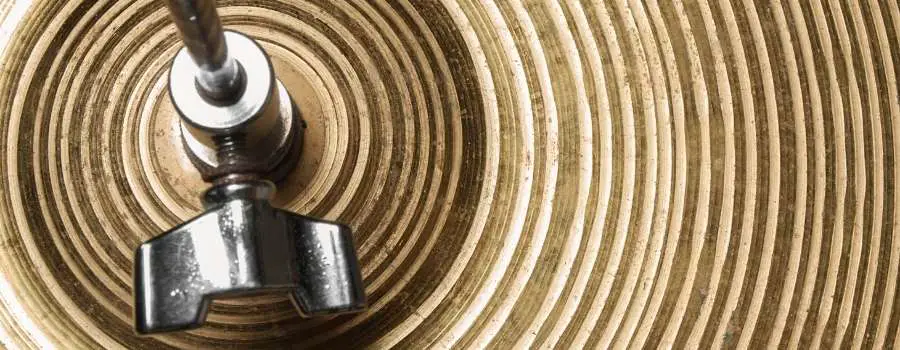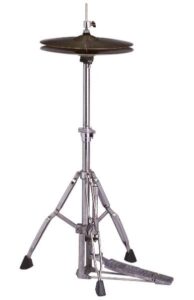I remember watching a show on PBS as a kid that featured a jazz drummer who played an entire song on just a hi-hat…no other drums or instruments, just the hi-hat. For several minutes I was mesmerized as he made that thing “sing.” Remember back on that got me interested on some of the complexities involved with a hi-hat like the different types of hi-hat clutches and what they do..
A hi-hat clutch is a device that attaches the top hi-hat cymbal to the hi-hat stand. The clutch tightens down onto the stand so that when the foot pedal is pressed it will lower the top hi-hat cymbal onto the lower one, allowing the drummer to “open” and “close” the hit-hat while playing.

Without a hi-hat clutch you would just have 2 cymbals sitting on top of each other…basically a permanently closed hi-hat. A hi-hat clutch greatly transforms what the drummer can do…it’s a deceptively simple device, so let’s go over some details.
How Does A Hi-Hat Clutch Work?
A standard hi-hat clutch is made up of a central metal screw, felt pads, and tighteners. Again, a deceptively simple device.
The central screw goes down over the hi-hat stand, one of the felt pads goes on top of that, then the top hi-hat cymbal, and then a felt pad on top. These pads can be loosened or tightened with disk grip (knurled) tighteners. The whole device holds onto the stand with a wing nut tightener.
The whole mechanism grips the hi-hat stand and as the player presses the foot pedal the stand move down, bringing the top cymbal down closing the hi-hat. When the player releases the pedal, the top cymbal raises back up which opens the hi-hat.
Drummers can adjust how high the top cymbal sits above the bottom cymbal by loosening the clutch and moving it up and down, then retightening. This can be done for various styles of music where the player may need quicker open/close action or just adjust to suit the player’s comfort.
What Types Of Hi-Hat Clutches Are There?

There are four types of hi-hat clutches but the first two I’ll talk about are the most common with the other two being more of a special style:
- Standard
- Quick Release
- Drop Clutch
- Incremental Clutch
Standard
A standard clutch is the style I described above, felt pads between tighteners that all grip a hi-hat stand using a wing nut screw. These are going to be the most common style, especially on inexpensive kits. Like drumsticks, drummers will often have their own clutches of various styles so they can change them out as needed.
Quick Release
A quick-release clutch is intended for gigging drummers who may need to set up and tear down quickly or to be able to change out hi-hats between songs. These are similar to standard clutches but instead of a wing nut style of screw, they usually have a mechanism that attaches and releases with one press.
One particular quick release, the DW Split Hi-Hat Clutch is designed to stay attached to the bottom hi-hat cymbal when stored in a gig bag basically, only the top of the clutch needs to be removed.
Drop Clutch
These are used by drummers that have a double bass setup. If the drummer is playing a passage that requires them to play two bass drums, they can hit the drop clutch with a stick to set the hi-hat to a closed position. Then, if needed, they can re-engage the clutch and play the hi-hat normally (being able to open and close with a pedal.)
Incremental Clutch
Drummers will use these clutches when they want to attach hi-hat cymbals to a standard cymbal stand rather than a hi-hat stand. These clutches will allow a player to quickly open or close the hi-hats so they can play extended passages in either position.
These are great if for players that don’t want to take their hi-hat stands with them or the extra foot pedal. However, they are limited in that you can’t open and close the hi-hat on the fly like with standard or quick-release clutches.
Can Hi-Hat Clutches Be Used Universally?
In general, hi-hat clutches can be used universally since most hardware used in drumming is built to a standardized measurement. Most hi-hat stands have a center rod that is 7 or 8 millimeters in diameter and so clutches are built to fit this standard.
The only issue some drummers have experienced, and this is a problem for clutches in general, is over-tightening has lead to the bottom pad splitting. But with just a little attention and care while placing a clutch, this shouldn’t be an issue.
Hi-Hat Clutch Maintenance
The great thing about hi-hat clutches is that they rarely break or need that much maintenance. Since they are typically made out of stainless steel or other durable metal they won’t rust or easily corrode.
Over time some grit and gunk may get into the screw mechanisms, but that’s nothing a little WD-40 or canned graphite can’t take care of.
The most vulnerable part of the clutch is the pads themselves. Since they are typically made out of dense felt, it is possible for them to fray and breaks down.
When this happens you have two main option, replace the pads or replace the whole clutch.
Depending on the model a hi-hat clutch will set you back less than $20 (and usually closer to $10 – $15 for most models.) Part kits can be bought for around $8 -$10 and will include some screws and several pads. Pads alone will set you back about $4.
It’s never a bad idea to have some extra parts in your gig bag and a whole repair kit back at your home studio. Over the years, as you buy and replace clutches…and other parts…just discard what is bad and store what is still good. Over time you’ll likely end up with a whole drawer full of replacement hi-hat clutch pads.
Final Thoughts
Hi-hat clutches…a deceptively simple device that allows for a simple pair of cymbals to become a three-in-one instrument. So many playing techniques and sound came about because someone had the genius idea of developing a way for a drummer to bang drums and crash cymbals all at the same time.
From the humble beginning as a “Sock Cymbal” mounted at ground level to the foot pedal and chain operated contraption we have today, hi-hats have gone hi-tech!
